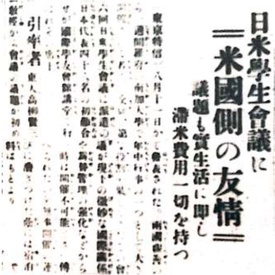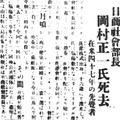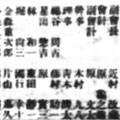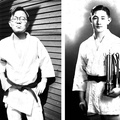CONNECTION BETWEEN THE UNIVERSITY OF WASHINGTON AND JAPANESE COMMUNITY
“Female Students from UW Go Sightseeing in Japantown” (August 17, 1938 issue)
Thirty-five female students taking summer classes at UW went sightseeing in Japantown. An event that was arranged by YMCA at UW. Though we call them a group of female students, some were high school students taking summer classes and others were elementary school teachers; there were even some elderly ladies with grey hair.
The group first visited the Japanese school, enjoyed Mr. Kubota’s Japanese garden so much that they kept on calling out the word “wonderful,” had their sense of curiosity stimulated at the Nichiren church, and stopped by the Nippon Sei Ko Kai (The Anglican Episcopal Church in Japan). They then visited our headquarters, walked around the factory asking a series of tricky questions, got a chance to see the rotary press in operation, and bought one copy of The North American Times and left the office.
After that they tried some Japanese sweets at Sagami-ya on Main Street, flipped through some Japanese magazines next door at Sanrindo, looked inside Toyo-uoten (fishmonger), and enjoyed a Japanese meal at Maneki-tei leaving the place feeling completely satisfied.
“Wardrobe from the Heian Era at the UW Museum” (November 12, 1938 issue)
Mr. Miyatake has treasured the wardrobe that was worn by the presiding officer at the coronation ceremony of the present emperor and it has been decided that he will donate it as a token of appreciation to UW that educates a great number of Japanese students. . . .UW is deeply touched by Mr. Miyatake’s benevolence and has decided to display it at the tokonoma alcove in its grand museum which was given by the International Culture Promotional Association.
“Documents of ‘Kumadori’ in Kabuki Given to the Drama Department at the UW” (March 20, 1940 issue)
Some documents of the unique make-up technique called kumadori which is used in Kabuki, a traditional form of Japanese theatre, will be donated as the source of “Japanese Drama Studies” at the UW.
COMPARING COLLEGE STUDENTS IN JAPAN AND AMERICA
Sumiyoshi Arima, the president of The North American Times, talked about college students in Japan and the U.S. in his column “Hokubei Shunju” as follows.
“College Students in America and Japan” (December 13 and 14, 1938 issues)
The great majority of college students in Japan seem to be just slacking off. This is because the college system itself is built in a way that lets them pass classes without much work. And the reason behind it is they only get to take one exam at the end of the term, so as long as they cram for the exam, as in the image of those with twisted towels around their head, just hard enough to get a passing score, they are good to go. . . .
Their schools don’t have facilities such as common rooms, places to hang out or student clubs, so this leads to nearby mahjong halls and cafes all filling from the morning. . . .
College students in America also seem to be enjoying their time a lot but it seems that they study when they do need to study. The terms at state universities in particular give their students exams one after another so they don’t have an easy time. The things at UW in recent years seem to have gotten worse.
The way the students have fun is quite different as well, but this is probably natural, considering that we act differently on a fundamental level in an institution where males and females do not mingle. Though we cannot state which is better in simple terms, I believe the fact that college students in Japan do not get the freedom and chance to be in relationships should be taken more seriously as a problem in the future.
CONFERENCE OF JAPANESE AND AMERICAN STUDENTS
The conference of Japanese and American students was first held in Tokyo in 1934. The second one was held in America in the following year and from there it was held in both countries in turn every year until 1940.
The First Conference
“Building Friendship Between Japan and the U.S. Starts with Students” (August 1, 1934 issue)
For four days from July 14, the conference of Japanese and American students was held at the Tokyo Metropolitan Hibiya Public Hall with 77 participants from the U.S. and 60 participants from Japan. . . .
The conference was broadcast live by radio. With the slogan ‘Building Friendship Between Japan and the U.S. Starts with Students,’ roundtable discussions were held on the following topics in each group of students: economy with 34 students, international issues with 50 students, politics with 16 students, and religion with 30 students.
The Second Conference
“The Conference of Japanese and American Students Takes Place in the U.S.” (November 8, 1934 issue)
The conference will be held in the summer next year in the U.S. and 100 students from Japan are expected to attend.
The Sixth Conference
“Participants of the Conference of Japanese and American Students Officially Announced” (July 10, 1939 issue)
The conference will start on August 11 at the University of Southern California in California, and 34 male students and 14 female students will attend from Japan (their schools and names are listed).
“American Friendship at the Conference of Japanese and American Students” (July 15, 1939 issue)
The 48 students planning to attend the sixth conference of Japanese and American students which will be held for a week from August 11 at USC met for the first time at the International Students Institute. . . .
They heard a sincere offer from the American side; they stated they would not only pay for accommodations, but all expenses during the stay and give allowances to those in need. The offer also included the message: “Please send over our precious friends.” It was comforting to know if and when the conference were to be carried out as planned despite some obstacles such as the not-so-great relationship between the two countries today and the strengthening of currency exchange control which reportedly could have canceled the event.
They were informed of this friendship anecdote and learned that the conference was made possible with the mediation of the Ministry of Foreign Affairs; the Ministry was moved by this beautiful friendship shown by America.
We can also see that the topics of discussion proposed by the American side are not like the ones discussed at the past conferences, such as literature or art, but those rooted in real life: current international problems, economic problems in the Pacific, military and national security, politics and its trends in both Japan and the U.S., working conditions, challenges for students, customs, religion, and so on.
This also comes from the American side’s willingness and thoughtfulness to listen to what Japan has to say in its honesty, when Japan is in a disadvantaged position internationally, and to see Japan in its bare form.
“Participants of the Conference of Students Leave Los Angeles Today” (August 23, 1939 issue)
The participants of the conference, after the conference at USC ended on the 18th, leave Los Angeles on the 23rd. They will visit the Los Angeles Exposition on the 27th, leave San Francisco on the 30th, arrive at Seattle via Portland and board Heian-maru on September 17 to return to Japan.
There was an article reporting the speeches that were given by the participants of the conference when they visited Seattle on September 12.
“Student Speeches Last Night” (September 13, 1939 issue)
The speeches by the participants from Japan who attended the Conference of Japanese and American Students were given last night at the Japan hall with 400 people in the audience from in and out of the country.
Educational director Fujihira led the event as the Master of Ceremony. Students gave their speeches one by one, addressing various topics, such as the progress and their impression of the Conference of Japanese and American Students, their thoughts on the world in relation to Japan and America, the current situation of women, Japan’s economic development, Japanese economy during wartime, and family life in Japan. Their speeches were full of enthusiasm and passion which can often be found in a young student and were well-received with a great round of applause.
The Seventh Conference
“The Seventh Student Conference To Be Held in Tokyo This Summer” (January 31, 1940 issue)
Six students will be sent from UW. After the one-week conference they will go on a trip for about three weeks invited by the Japan side and travel around some areas in Japan as well as Manchukuo. They will leave San Francisco on July 1.
THE UNIVERSITY OF WASHINGTON DURING THE JAPAN-U.S. WAR
I found an English article published right before the start of Nikkei incarceration in 1942 reporting on Nisei students at the University of Washington. The below is its summary.
“U.W. Campus Nisei Still on Job” (Front page of the February 27, 1942 issue).
The university authorities made the following comment today: residents are demanding that Nisei who work at public schools in Seattle City be fired. As for the 22 Nisei who are employed at the University of Washington, however, such action has not been made as of now.
Those Nisei are full-time employees working at among 1700 facilities that hold office employees, workers on the site, and others. Out of the 22, six of them are faculty and only one is a member of the facility.
Henry F. Tatsumi is a veteran of the U.S. army from WWI and currently is an associate professor of East Asian studies. The other five are lecturers at graduate school. The rest are hired as either full-time or part-time staff at various departments in the school as office workers.
There was an article about the students at the University of Washington during the war.
“424 Nisei at UW” (March 6, 1942 issue)
According to the report from UW authorities, 435 Japanese students filed their applications for admission at the beginning of the year, and only 11 of them were Japanese citizens. The rest of them reportedly were all Nikkei citizens. . . . As of now, there is no plan for the school to expel those students.
IN CONCLUSION
There were few Japanese students at the University of Washington around 1919, but the number kept increasing and reached 102 in 1926, 250 in 1939, and 435 in 1942; most of them were American-born Nisei. Also, the percentage of female students in 1908 was 0; however it went up to 25% in 1926 and reached 40% in 1939, which shows that more and more Nisei women went to college as time passed. Nisei children who acquired skills at a university in America overcame various obstacles and made outstanding accomplishments in a number of different fields.
The next chapter will introduce articles about Japanese American Citizens League which was established as a Nisei political organization.
References:
Jyushiro Kato, History of Development of Japanese in the United States, Hakubun-sha, 1908.
Hokubei Nenkan, Hokubei jijisha, 1928.
Kojiro Takeuchi, History of Japanese Immigrants in the Northwestern United States, Taihoku Nippo-sha, 1929.
*The English version of this series is a collaboration between Discover Nikkei and The North American Post, Seattle’s bilingual community newspaper. This article was originally publishd in Japanese on June 1, 2022 in The North American Post.
© 2022 Ikuo Shinmasu









